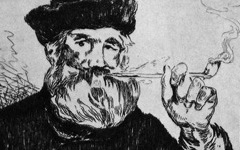Manet’s Café-Concert (1878)
Edouard Manet's varied scenes of Parisian cafés are almost always described as sociological observations, as though copying reality was his objective. Art historians like Linda Nochlin, with an interest in sociology, are particularly prone to that interpretation. Like artists, they paint themselves. We all tend to. It cannot be so, of course, because, if you have learnt anything from this website, you will have learnt that great artists never copy what they see....and Manet's scenes in cafés are no different.
At first sight the most curious feature of this painting is the lifeless figure of the smoking woman at left. Yet when one knows her source - the earlier figure on which she is based - her oddness begins to make sense.
Click next thumbnail to continue

L: Detail of engraving after Boucher's copy of a lost Self-Portrait by Watteau
R: Detail of Manet's Café-Concert
Click image to enlarge.
Just as Manet based his portrait of Angelina on Boucher's copy of a lost self-portrait by Watteau so he used the same engraving here for the girl at left. Note how those odd, arched eyebrows and the raised collar find their counterparts in Watteau's figure. The girl is "an artist".
Click next thumbnail to continue
To strengthen this association, the girl smokes, a traditional symbol for thought and creative imagination, while the hand holding the cigarette is placed directly above Manet's signature. She is both "Watteau" and "Manet", representing one great master's identification with another. As a woman and "artist" too, she also symbolizes the androgyny of Manet's mind.
Click next thumbnail to continue
The girl's slouched and lifeless figure distinguishes her from the vigorous and alert man next to her, as though on a different level of consciousness. Resembling one of those lifeless mannequins often found in studios of the time, she is his "painting" and, as an artist, his self-representation too1.
The man, wearing the top hat Manet always did in public, is a representation of Manet as the "painter". We know this because the fingers of his prominent hand - the symbol of his craft - form the letter M for Manet.
Click next thumbnail to continue
In a slightly later café scene Manet places the smoker facing the canvas as though he is "painting" the scene in front of him with his pipe. We have seen something similar in several other paintings by Manet.2 That is why he seems so much larger and fully-formed than the other figures. They are painted flatly because they are in "a flat painting".
The man's arm also rests on a table in the lower corner of the image, its edge in strong perspective. This makes it resemble an artist's work-table (in our "space") with glasses of alcohol in place of pots of paint. Manet often used that metaphor, most notably in both his very first and very last last masterpieces, The Absinthe Drinker and A Bar at the Folie-Bérgère.3
See conclusion below
Manet's café scenes are not, as always argued, representations of exterior reality but, like most great art, a studio in the artist's mind where the painting itself is in the process of creation. Their setting in the theater-like space of a café-concert is also significant because artists often think of their art as a performance. The actual singer, glimpsed in the distance in each case and freely brushed as though in Impressionist style, might just as well be in a framed painting. Manet was a poet, not a photographer, and his art contains ideas and methods that he learnt from art and used in art. Performance, mirrors, androgyny, the artist's hand, one artist's identification with another are all common characteristics of great art that can be seen in the most unexpected places. Once you learn how to recognize them here, your visits to museums will never be the same again.
More Works by Manet
Skating on ice is like drawing lines on the mirrored surface of the artist's mind

Manet’s Skating (1877)
Notes:
1. See the mannequin in Degas' Portrait of Henri-Michel Levy (1878-9), perhaps painted the same year as Manet's Café-Concert.
2. Examples on this site include Manet's Interior at Arachon (1871), Bon Bock (1873) and The Smoker (c.1866)
3. An entry on Manet's A Bar is in the works. it will demonstrate that the table in front of the maid represents an artist's work-table covered in "pots of paint" and bottles of "paint thinner" and "cleaning fluid".
Original Publication Date on EPPH: 28 Dec 2010. | Updated: 0. © Simon Abrahams. Articles on this site are the copyright of Simon Abrahams. To use copyrighted material in print or other media for purposes beyond 'fair use', you must obtain permission from the copyright owner. Websites may link to this page without permission (please do) but may not reproduce the material on their own site without crediting Simon Abrahams and EPPH.






